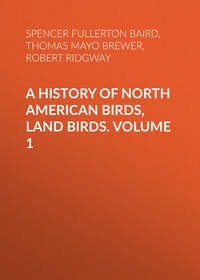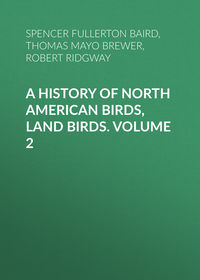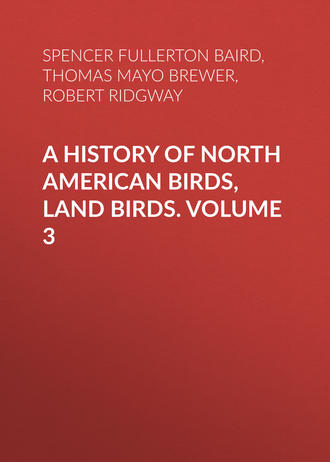 полная версия
полная версияA History of North American Birds, Land Birds. Volume 3
This Owl is not unfrequently kept in confinement. It seems easily reconciled to captivity, becomes quite tame, suffers itself to be handled by strangers without resenting the familiarity, but is greatly excited at the sight of mice or rats. Captain Bland had one of these birds in captivity at Halifax, which he put into the same room with a rat. The bird immediately attacked and killed the rat, but died soon after of exhaustion.
The notes of this Owl, during the breeding-season, are said to resemble the noise made by the filing of a saw, and it is known in certain localities as the Saw-Whet. Mr. Audubon, on one occasion, hearing these notes in a forest, and unaware of their source, imagined he was in the vicinity of a saw-mill.
According to Mr. Audubon, this Owl breeds in hollow trees, or in the deserted nests of other birds; and lays from four to six glossy-white eggs, which are almost spherical. He states, also, that he found near Natchez a nest in the broken stump of a small decayed tree not more than four feet high. He also mentions the occasional occurrence of one of these Owls in the midst of one of our crowded cities. One of them was thus taken in Cincinnati, where it was found resting on the edge of a child’s cradle. Mr. McCulloch, quoted by Audubon, gives an interesting account of the notes and the ventriloquial powers of this bird. On one occasion he heard what seemed to him to be the faint notes of a distant bell. Upon approaching the place from which these sounds proceeded, they appeared at one time to be in front of him, then behind him, now on his right hand, now on his left, again at a great distance, and then close behind him. At last he discovered the bird at the entrance of a small hole in a birch-tree, where it was calling to its mate. As he stood at the foot of the tree, in full sight of the bird, he observed the singular power it possessed of altering its voice, making it seem near or remote,—a faculty which he had never noticed in any other bird.
An egg given me by Mr. Rufus E. Winslow as one of this bird, and figured in the North American Oölogy, was undoubtedly that of a Woodpecker. It is of a crystalline whiteness, nearly spherical, and measures 1.13 inches in length by .87 of an inch in breadth.
A well-identified egg in the collection of the Smithsonian Institution, taken by Mr. R. Christ at Nazareth, Penn., (No. 14,538, S. I.,) measures .95 of an inch by .88. The two ends are exactly similar or symmetrical. The egg is white, and is marked as having been collected April 25, 1867.
Genus SCOPS, Savigny
Scops, Savigny, 1809. (Type, Strix scops, L. = Scops zorca (Gm.) Swains.)
Ephialitis, Keys. & Bl. 1840, nec Schrank, 1802.
Megascops, Kaup, 1848. (Type, Strix asio, L.)
Gen. Char. Size small, the head provided with ear-tufts. Bill light-colored; iris yellow. Three to four outer quills with inner webs sinuated. Wings long (more than twice the length of the tail, which is short and slightly rounded); second to fifth quills longest. Toes naked, or only scantily feathered. Ear-conch small and simple. Plumage exceedingly variegated, the colors different shades of brown, with rufous, black, and white, in fine mottlings and pencillings; feathers above and below usually with blackish shaft-streaks, those beneath usually with five transverse bars; primaries spotted with whitish, and outer webs of the lower row of scapulars the same edged terminally with black. Tail obscurely banded.
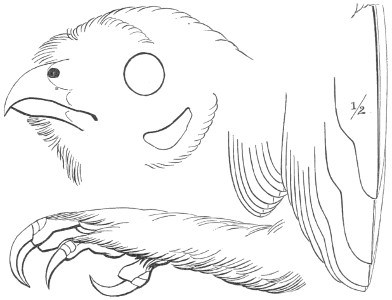
½
Scops asio.
The species of this genus are cosmopolitan, the greater number, however, being found in tropical regions. All the American species differ from S. zorca of Europe in having the fourth and fifth quills longest, instead of the second, and in having three to four, instead of only two, of the outer quills with the inner web sinuated, as well as in having the quills shorter, broader, and more bowed, and their under surface more concave. They may, perhaps, be distinguished as a separate subgenus (Megascops, Kaup). Of the American species all but S. asio (including its several races) have the toes perfectly naked to their very bases.
Species and RacesCommon Characters. Plumage brown, gray, or rufous, and whitish, finely mottled above; lower parts transversely barred, and with dark shaft-streaks. Outer webs of lower scapulars light-colored (white or ochraceous) and without markings. Tail crossed by rather obscure mottled light and dark bars of nearly equal width. Outer webs of primaries with nearly equal bands of whitish and dusky.
1. S. asio. Toes covered (more or less densely) with bristles, or hair-like feathers. Wing, 5.50–7.80; tail, 3.20–4.10; culmen, .50–.70; tarsus, 1.00–1.70; middle toe, .70–.80. Ear-tufts well developed; facial circle black.
Colors smoky-brown and pale fulvous, with little or none of pure white. Outer webs of the scapulars pale ochraceous-fulvous. Wing, 6.90–7.30; tail, 3.50–4.50. Hab. North Pacific region, from Western Idaho and Washington Territory, northward to Sitka … var. kennicotti.
Colors ashy-gray and pure white, with little or none of fulvous. Outer webs of the scapulars pure white. Varying to bright brick-red, or lateritious-rufous.
Mottlings coarse, the blackish median streaks above not sharply defined, and the bars beneath heavy and distinct.
Wing, 6.10–7.75; tail, 3.30–4.35. In the red plumage, white prevailing on the lower parts, where the red markings are not broken into transverse bars. Hab. United States; except the Southern Middle Province, the northwest region, and Florida … var. asio.
Wing, 5.50–6.00; tail, 2.75–3.10. In the red plumage, red prevailing on the lower parts, where the markings are much broken into transverse bars. Hab. Florida and Southern Georgia … var. floridanus.
Wing, 5.50–5.80; tail, 3.20–3.30. Gray plumage, like var. asio, but the mottling above much coarser, and the nape with a strongly indicated collar of rounded white spots in pairs, on opposite webs. Red plumage not seen. Hab. Eastern Mexico and Guatemala … var. enano.25
Mottlings fine, the blackish median streaks above very sharply defined and conspicuous; bars beneath delicate and indistinct.
Wing, 6.20–6.50; tail, 3.35–3.50. Hab. Southern Middle Province, and Southern California; Cape St. Lucas … var. maccalli.
2. S. flammeola. Toes perfectly naked, the feathering of the tarsus terminating abruptly at the lower joint. Wing, 5.40; tail, 2.80; culmen, .35; tarsus, .90; middle toe, .55. Ear-tufts short, or rudimentary. Facial circle rusty. Outer webs of the scapulars rusty-ochraceous, in striking contrast to the grayish of the wings and back. Other markings and colors much as in asio. Hab. Mountain regions of Mexico and California, from Guatemala to Fort Crook, Northern California.
Scops asio, BonapLITTLE RED OWL; MOTTLED OWL; “SCREECH-OWL.”Noctua aurita minor, Catesby, Carol. I, 1754, 7, pl. vii. Asio scops carolinensis, Briss. Orn. I, 1760, 497. Strix asio, Linn. Syst. Nat. 1758, 92.—Gmel. S. N. 1789, 287.—Lath. Ind. Orn. 1790, 54.—Ib. Syn. I, 123.—Ib. Supp. I, 42; Gen. Hist. I, 314.—Daud. Tr. Orn. II, 1800, 216.—Shaw, Zoöl. VII, 1809, 229.—Temm. Pl. Col. 80.—Wils. Am. Orn. 1808, pl. xlii, f. 1.—Jard. (ed. Wils.) Orn. I, 1831, 307.—Bonap. Ann. N. Y. Lyc. II, 36.—Ib. Isis, 1832, 1139.—Audubon, Birds N. A. 1831, pl. xcvii.—Ib. Orn. Biog. I, 486.—Brewer (ed. Wils.) Orn. 1852, p. 687.—Hobs. Nat. 1855, 169. Bubo asio, Vieill. Ois. Am., Sept., 1807, 53, pl. xxi.—Giraud, Birds Long Island, 1844, 28.—Max. Cab. J. VI, 1858, 23. Otus asio, Stephens, Zoöl. XIII, pt. ii, 1815, 57. Scops asio, Bonap. List, 1838, 6.—Less. Tr. Orn. 107.—Cass. Birds Cal. & Tex. 1854, 179.—Ib. Birds N. Am. 1858, 51.—Kaup, Monog. Strig. Cont. Orn. 1852, 112.—Strickl. Orn. Syn. I, 1855, 199.—Heerm. P. R. Rept. II, 1855, 35.—Coop. & Suckl. P. R. Rept. 155.—Maynard, Birds Eastern Mass., 1870, 131.—Coues, Key, 1872, 202.—Gray, Hand List, I, 1869, 46. Ephialtes asio, Gray, Gen. B. fol. 1844, sp. 9.—Ib. List Birds Brit. Mus. 1844, p. 96.—Woodh. 1853, 62. Strix nævia, Gmel. S. N. 1789, 289.—Lath. Ind. Orn. 1790, p. 55.—Ib. Syn. I, 126; Gen. Hist. I, 321.—Daud. Tr. Orn. II, 1800, 217.—Shaw, Zoöl. VII, 1809, 230.—Wils. Am. Orn. 1808, pl. xix, f. 1. Asio nævia, Less. Man. Orn. I, 1828, 117. Otus nævius, Cuv. Reg. An. (ed. 2), I, 1829, 341. Surnia nævia, James. (ed. Wils.), Orn., 1831, I, 96 & 99.
a. Normal plumageSp. Char. Adult. Ground-color above brownish-cinereous, palest on the head, purest ashy on the wings, minutely mottled with fine zigzag transverse bars of black, each feather with a medial ragged stripe of the same along the shaft. Inner webs of ear-tufts, outer webs of scapulars, and oval spots occupying most of the outer webs of the two or three lower feathers of the middle and secondary wing-coverts, white, forming (except on the first) conspicuous spots, those of the scapulars bordered with black. Secondaries crossed with about seven regular paler bands, each enclosing a more irregular dusky one; the ground-color, however, is so mottled with grayish, and the pale bands with dusky, that they are by no means sharply defined or conspicuous, though they are very regular; alula and primary coverts more sharply barred with cream-colored spots, those on the former nearly white; primaries with broad quadrate spots of creamy-white on outer webs, these forming from seven (♂) to eight (♀) transverse bands, the last of which is not terminal. Tail more irregularly mottled than the wings, and crossed by seven (♂) to eight (♀) narrow, obsolete, but continuous, pale bands.
Eyebrows white, the feathers bordered with dusky (most broadly so in ♂); cheeks, ear-coverts, and lower throat dull white, with transverse bars of blackish (most numerous in the ♂); chin immaculate; upper eyelid dark brown; facial circle black; neck and jugulum like the cheeks, but more strongly barred, and with blackish along the shaft. Ground-color of the lower parts white, each feather with a medial stripe of black, this throwing off distinct bars to the edge of the feather; the medial black is largest on sides of the breast, where it expands into very large conspicuous spots, having a slight rusty exterior suffusion; the abdomen medially, the anal region, and the lower tail-coverts, are almost unvaried white. Tibiæ and tarsi in the male dull white, much barred transversely with blackish; in the female, pale ochraceous, more sparsely barred with dark brownish. Lining of the wing creamy-white, varied only along the edge; light bars on under surface of primaries very obsolete.
♂ (16,027, Fort Crook, North California; John Feilner). Wing, 6.70; tail, 3.80; culmen, .61; tarsus, 1.35; middle toe, .72; ear-tufts, 1.00; wing-formula, 3=4, 5–2, 6, 1=9. “Length, 9.50; extent, 23.75.”
♀ (18,299, Hellgate, Montana; Jno. Pearsall). Wing, 7.80; tail, 4.10; culmen, .70; tarsus, 1.70; middle toe, .80; ear-tufts, 1.00.
Young ♂ (No. 29,738, Wood’s Hole, Mass., July 25, 1863; S. F. Baird. “Parent gray”). Secondaries, primaries, and tail, as in the adult, gray plumage; but the latter more mottled, the bands confused. Rest of the plumage everywhere grayish-white, with numerous transverse bars of dusky-brown; eyebrows and lores scarcely variegated dull white; facial circle obsolete.
♀ (41,891, Philadelphia, Penn.; J. Krider). Whole head, neck, back, rump, and entire lower parts transversely barred with dark brown and grayish-white, the bands of the former on the upper parts rather exceeding the white in width, but on the lower surface much narrower; scapulars with large transverse spots of white on the outer webs. Wings and tail as in the adult. Facial disk conspicuous. (More advanced in age than the preceding.)
b. Rufescent plumageAdult. General pattern of the preceding; but the grayish tints replaced by lateritious-rufous, very fine and bright, with a slight vinaceous cast: this is uniform, and shows no trace of the transverse dark mottling; there are, however, black shaft-lines to the feathers (these most conspicuous on the head above, and scapulars, and narrower and more sharply defined than in the gray plumage). The inner webs of the ear-tufts, outer webs of scapulars, and lower secondary and middle wing-coverts, are white, as in the gray plumage; those of the scapulars are also bordered with black. The secondaries, primaries, and tail are less bright rufous than the other portions, the markings as in the gray plumage, only the tints being different. The upper eyelid, and, in fact, all round the eye, fine light rufous; cheeks and ear-coverts paler, scarcely variegated; black facial circle rather narrower than in the gray plumage. Lower parts without the transverse bars of the gray plumage, but in their place an irregular clouding of fine light red, like the back; the lower parts medially (very broadly) immaculate snowy-white; most of the feathers having the red spotting show black shaft-stripes, but the pectoral spots are not near so large or conspicuous as in the gray bird. Tibiæ fine pale ochraceous-rufous; tarsi the same posteriorly, in front white with cuneate specks of rufous; lower tail-coverts each with a medial transversely cordate spot of dilute rufous, the shaft black. Lining of the wing with numerous rufous spots.
♂ (12,045, Washington, D. C., January). Wing, 6.30; tail, 3.00.
♀ (22,512, Maryland; R. G. Campbell). Wing, 6.70; tail, 3.50.
Young (29,792, Peoria, Illinois; Ferd. Bischoff). Wings and tail as in adult; markings on head and body as in the young gray bird, but white bars more reddish, and dark ones more brown.
Hab. Temperate North America, from the South Atlantic States to Oregon, and from the northern United States to Texas. Replaced in the southern Middle Province and Southern California by var. maccalli, in Florida by var. floridana, and on the northwestern coast region by var. kennicotti.
Localities: (?) Cuba (Cabanis, Journ. III, 465).
The above stages of plumage have caused ornithologists a great deal of perplexity; and it is only very recently that they have become correctly understood. Even yet many persist in regarding the red plumage as being that of the young bird.
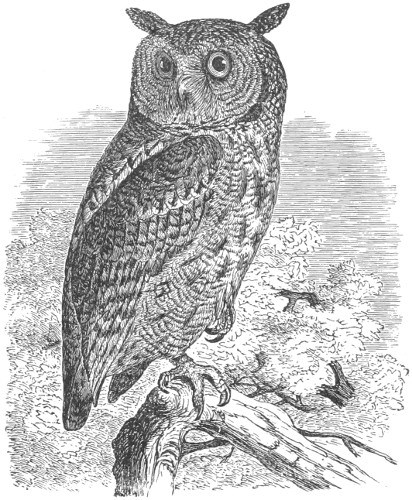
Scops asio.
That these two very different plumages are entirely independent of age, sex, or season, and that they are purely individual, there can be no doubt; since in one nest there may often be found both red and gray young ones, while their parents may be either both red or both gray, the male red and the female gray, or vice versa. Occasionally specimens (such as No. 39,093, ♂, Neosho Falls, Kansas, April 13; parent of five eggs, and captured on the nest with a gray male) are exactly intermediate between these two plumages, it being difficult to decide which predominates; the combination is not only of the tints, but of the markings, of the two stages.
Habits. The habit of all the varieties of Scops asio in their different localities will be found after their zoölogical description.
Scops asio, var. floridana, RidgwayScops asio, Allen, Bull. Mus. Comp. Zoöl. and other citations from Florida.
Char. Similar to var. asio, but much smaller, and the colors deeper. The gray stage very similar to that of var. asio, but the red phase very appreciably different, in there being a greater amount of rufous on the lower parts, the breast being nearly uniformly colored, and the rufous broken elsewhere into transverse broad bars, connected along the shaft. Wing, 5.50–6.00; tail, 2.75–3.10.
Hab. Florida and Lower Georgia.
This extreme southern form is much smaller than the more northern ones, being about the same in size as the var. enano (see p. 1374) of Middle America, and the S. atricapilla, Temm., of Tropical America generally. The colors, as may be expected, are also darker and richer.
In the collection of the Smithsonian Institution there are both red and gray birds from Florida; a red one (No. 5,857, Indian River; Dr. A. W. Wall) measures, wing, 5.50; tail, 2.70; culmen, .55; tarsus, 1.05; middle toe, .65; ear-tufts, .70. The colors are much darker than those of typical asio. The rufous of the neck, all around, shows obsolete darker transverse bars; the black border to the white scapular spots is restricted to the tip, as in the gray plumage; the inner webs of the ear-tufts are scarcely paler than the outer; the neck and face are deeper rufous, while the rufous of the lower parts is more general, and more in transverse rays; tibiæ and tarsi plain rufous; the middle of the abdomen and the anal region only are pure white.
Scops asio, var. maccalli, CassWESTERN MOTTLED OWLScops maccalli, Cass. Birds Cal. & Tex. p. 180, 1850; Birds N. Am. 1858, 52.—Strickl. Orn. Syn. I, 200, 1865.—Coues, Prod. Orn. Ariz., p. 13, 1869.—Scl. & Salv. P. Z. S., 1868, 57 (= trichopsis, Wagl. Isis, 1832, 276! see remarks below).—Baird, Mex. Bound. II, 4, pl. i.—Gray, Hand List, I, 47, 1869. Scops asio, var. maccalli (Ridgway) Coues, Key, 1872, 203. Ephialtes choliba (not of Vieillot!), Lawr. Ann. N. Y. Lyc. VI, 1853, p. 4.
Char. Adult (9,147, Camp 118, New Mexico, February 10, 1854; Kennerly and Möllhausen). Above cinereous, the ashy appearance being caused by a minute transverse mottling of blackish and pale ashy, on a deeper ash ground; each feather with a distinct medial stripe of black, these broadest on the forehead; outer webs of only a few scapulars white, these not bordered with black; outer webs of two or three lower middle and secondary coverts white. Secondaries with about seven transverse, mottled pale bands; primaries with about eight transverse series of white spots; tail with about eight narrow pale bands.
Ear-coverts, cheeks, throat, neck, and jugulum finely and uniformly barred transversely with dusky and grayish-white; the facial circle interrupted across the throat, where in its place is a series of longitudinal black dashes.
Lower parts grayish-white, with numerous, very narrow transverse bars of dusky, rather more distant from each other than those of the neck, etc.; each feather with a medial narrow stripe of black, those on the breast forming conspicuous spots; tibiæ and tarsi dull soiled white, with numerous spots of dark brown; lower tail-coverts immaculate. Wing-formula, 3=4–2, 5, 6, 7, 8–1–9. Wing, 6.50; tail, 3.30; culmen, .55; tarsus, 1.15; middle toe, .70; ear-tufts, .85.
(A specimen from California (Stockton, E. S. Holden), kindly sent by Mr. Lawrence for examination, differs from the preceding in rather more brown ground-color above; the black shaft-streaks more obscure. In other respects as regards plumage it is the same, and is typical maccalli. The size is less, it measuring, wing, 6.20; tail, 3.10.)
Young (first full, but incomplete plumage; 16,932, Cape St. Lucas, Lower California). Secondaries, primaries, and tail as in the gray adult. Rest of the plumage transversely barred with grayish-white and dusky, the latter predominating on the upper parts; eyebrows and lores white; rings finely transversely mottled with white, this forming spots on the lower feathers; tibiæ and tarsi with numerous transverse dusky bars. Wing, 5.40; tail, 2.65; tarsi, 1.00; middle toe, .63. No. 16,933 (same locality, etc.) is similar, but smaller, measuring, 5.00, 2.00, 1.00, and .60.
Hab. Southern Middle Province of United States; Lower and Southern California.
Localities. (?) Oaxaca (Scl. 1858, 296); (?) Guatemala (Scl. Ibis, I, 220); (?) Texas (Dresser, Ibis, 1856, 330).
While the Scops maccalli is without doubt to be distinguished from S. asio, its being specifically distinct is not a matter of so much certainty; with a simple statement of the differences between the two, I shall leave the value of these differences to the appreciation of each one, according to his own fancy. The species is represented in the collection by but four specimens, two adult and two young. I have not seen the red plumage as described by Cassin.
The characters of this race, as given in the diagnosis, appear to be really constant; and there is not a specimen in the series of those from the west which may not readily be referred to one or the other.
The gray adult maccalli differs from that of asio in the much finer mottling of the general plumage; the medial black stripes of the feathers above being more sharply defined, and more distinct from the transverse zigzags. Below, the transverse dark bars are much finer, and nearer together. The face, neck, and jugulum more finely and uniformly barred. The white scapular spots have not the black border seen in asio. The size is smaller.
The young of maccalli differs from that of asio in much finer bars above, the dusky rather prevailing; below, also, the bars are finer and nearer together.
It is not necessary to compare this bird with any other than the S. asio, since it is not at all related to choliba, or any other southern species.
Scops maccalli is entirely distinct from the S. trichopsis, Wagler, notwithstanding the statement in the Ibis, for April, 1872 (p. 6), that “the name” is “really synonymous with S. trichopsis of Wagler, the bird being quite distinct from S. asio, as has been pointed out elsewhere.” (P. Z. S. 1868, p. 57.)
Scops asio, var. kennicotti, ElliotKENNICOTT’S OWLScops kennicotti, Elliot, Pr. Ac. Nat. Sc. Phil. 1867, p. 69; Illust. Am. Birds, pl. xi.—Baird, Trans. Chicago Acad. Sc. I, ii, 311, pl. xxvii, 1869.—Dall & Bannister, Tr. Chic. Ac. I, 1869, 273.—Gray, Hand List, I, 47, 1869.—Elliot, Illust. Birds Am. I, xxvii.—Finsch, Abh. Nat. III, 28.—Scops asio, var. kennicotti, (Ridgway) Coues, Key, 1872, 203. ? Scops asio, Coop. & Suck. P. R. R. Rept. XII, ii, 155, 1860 (all citations from northwest coast).
Sp. Char. Adult (♂, 59,847, Sitka, Alaska, March, 1866; Ferd. Bischoff. Elliott’s type). Above umber-brown, with a reddish cast; feathers confusedly mottled transversely with dusky, and showing rounded spots of rufous, most conspicuous on the nape; each feather with a conspicuous medial broad ragged stripe of black, these stripes most conspicuous on the forehead and scapulars; outer webs of scapulars light rufous, bordered terminally with black. Wings of a more grayish cast than the back, but similarly variegated; lower feathers of the middle and secondary wing-coverts, each with a large oval pale rufous spot, covering most of the lower web. Secondaries crossed by six narrow obscure bands of pale rufous; primaries with seven somewhat rounded, quadrate spots of the same on the outer webs, forming as many transverse series; each light spot with a central dusky mottling. Tail more finely and confusedly mottled than the wings; the bands, though present, are so obsolete as to be scarcely traceable, and so irregular or badly defined as to be of uncertain number. The ear-tufts are black and rusty, the former along the shafts, and in transverse spots; on the outer webs the black predominates, on the inner the rusty.
The lores and basal half of the frontal bristles are white, the terminal half abruptly black; eyebrows about equally blackish and paler, the former bordering the feathers; eye surrounded by dark snuff-brown; cheeks and ear-coverts pale rusty, transversely barred with deeper rusty; facial circle not well defined, black. Chin and lores only white.
Ground-color of the lower parts dilute-rusty, becoming white on the flanks; each feather of the throat, jugulum, breast, sides, and flanks with a broad medial stripe of black, this throwing off very narrow, rather distant, bars to the edge; the spaces between these bars are alternately paler and deeper dilute-rusty; the black marks are broadest on the sides of the breast, where they have an external deep rusty suffusion; the abdomen medially, and the anal region, are scarcely maculate rusty-white; the lower tail-coverts have each a central cuneate longitudinal stripe of black. Tibiæ, tarsi, and lining of the wing, plain deep rusty. Wing-formula, 3=4, 5–2, 6–1=9. Wing, 7.40; tail, 4.00; culmen, .65; tarsus, 1.50; middle toe, .80.


